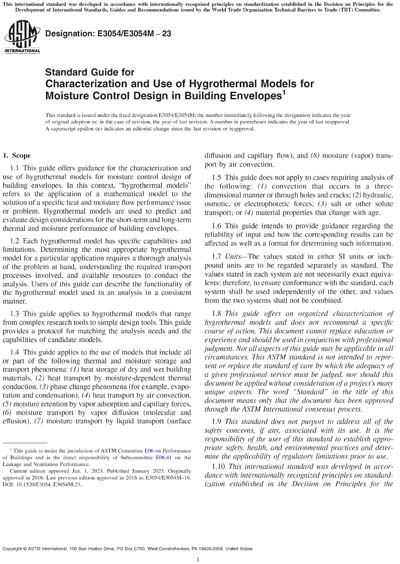Most recent
ASTM E3054/E3054M-23
Standard Guide for Characterization and Use of Hygrothermal Models for Moisture Control Design in Building Envelopes
1.1This guide offers guidance for the characterization and use of hygrothermal models for moisture control design of building envelopes. In this context, "hygrothermal models" refers to the application of a mathematical model to the solution of a specific heat and moisture flow performance issue or problem. Hygrothermal models are used to predict and evaluate design considerations for the short-term and long-term thermal and moisture performance of building envelopes.
1.2Each hygrothermal model has specific capabilities and limitations. Determining the most appropriate hygrothermal model for a particular application requires a thorough analysis of the problem at hand, understanding the required transport processes involved, and available resources to conduct the analysis. Users of this guide can describe the functionality of the hygrothermal model used in an analysis in a consistent manner.
1.3This guide applies to hygrothermal models that range from complex research tools to simple design tools. This guide provides a protocol for matching the analysis needs and the capabilities of candidate models.
1.4This guide applies to the use of models that include all or part of the following thermal and moisture storage and transport phenomena: (1) heat storage of dry and wet building materials, (2) heat transport by moisture-dependent thermal conduction, (3) phase change phenomena (for example, evaporation and condensation), (4) heat transport by air convection, (5) moisture retention by vapor adsorption and capillary forces, (6) moisture transport by vapor diffusion (molecular and effusion), (7) moisture transport by liquid transport (surface diffusion and capillary flow), and (8) moisture (vapor) transport by air convection.
1.5This guide does not apply to cases requiring analysis of the following: (1) convection that occurs in a three-dimensional manner or through holes and cracks; (2) hydraulic, osmotic, or electrophoretic forces; (3) salt or other solute transport; or (4) material properties that change with age.
1.6This guide intends to provide guidance regarding the reliability of input and how the corresponding results can be affected as well as a format for determining such information.
1.7Units - The values stated in either SI units or inch-pound units are to be regarded separately as standard. The values stated in each system are not necessarily exact equivalents; therefore, to ensure conformance with the standard, each system shall be used independently of the other, and values from the two systems shall not be combined.
1.8This guide offers an organized characterization of hygrothermal models and does not recommend a specific course of action. This document cannot replace education or experience and should be used in conjunction with professional judgment. Not all aspects of this guide may be applicable in all circumstances. This ASTM standard is not intended to represent or replace the standard of care by which the adequacy of a given professional service must be judged, nor should this document be applied without consideration of a project's many unique aspects. The word "Standard" in the title of this document means only that the document has been approved through the ASTM International consensus process.
1.9This standard does not purport to address all of the safety concerns, if any, associated with its use. It is the responsibility of the user of this standard to establish appropriate safety, health, and environmental practices and determine the applicability of regulatory limitations prior to use.
1.10This international standard was developed in accordance with internationally recognized principles on standardization established in the Decision on Principles for the Development of International Standards, Guides and Recommendations issued by the World Trade Organization Technical Barriers to Trade (TBT) Committee.
ASTM International [astm]

